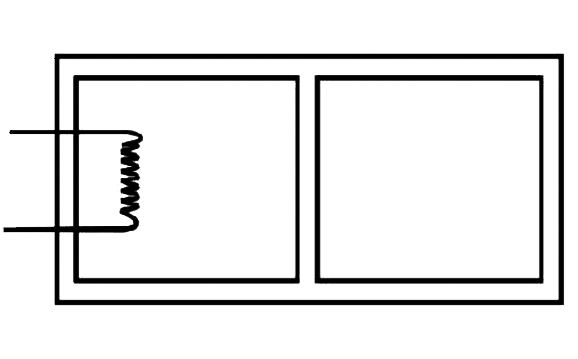A metal rod of Young's modulas Y and coefficient of thermal expansion α is held at its two ends such that its length remains invariant. If its temperature is raised by t∘c, then the linear stress developed in it is Solution in Gujrati
αtY
Yαt
Yαt
1(Yαt)
The correct Answer is:C
Strain =l2−l1l1=αt and Y=StressStrain
⇒ Stress = Yαt
Topper's Solved these Questions
- GEOMETRICAL OPTICSBook:ALLEN Chapter:GEOMETRICAL OPTICSExercise:EXERCISE - 05 (B)
Explore 58 Videos
- GEOMETRICAL OPTICSBook:ALLEN Chapter:GEOMETRICAL OPTICSExercise:EXERCISE - 05 (B) (MCQ)
Explore 9 Videos
- GEOMETRICAL OPTICSBook:ALLEN Chapter:GEOMETRICAL OPTICSExercise:EXERCISE - 04 (B)
Explore 15 Videos
- CURRENT ELECTRICITYBook:ALLEN Chapter:CURRENT ELECTRICITYExercise:EX.II
Explore 66 Videos
- GRAVITATIONBook:ALLEN Chapter:GRAVITATIONExercise:EXERCISE 4
Explore 9 Videos
Similar Questions
A vessel contains a mixture of one mole of oxygen and two moles of nitrogen at 300K. The ratio of the average rorational kinetic energy per O2 molecules to that per N2 molecules is
View SolutionLet ¯v,vrms and vp respectively denote the mean speed, the root-mean - square speed, and the most probable speed of the molecules in an ideal monoatomic gas at absolute temperature T. The mass of a molecule is m:-
View SolutionThe rectangular box shown in Fig has partition which can slide without friction along the length of the box. Initially each of the two chambers of the box has one mole of a mono-atomic ideal gas (λ=5/3) at a pressure P0, volume V0 and temperature T0. The chamber on the left is slowly heated by an electric heater. The walls of the box and the lead wires of the heater is negligible. The gas in the left chamber expands pushing the partition until the final pressure in both chambers becomes 243P0/32. Determine (i) the final temperature of the gas in each chamber and (ii) the work done by the gas in the right chamber.

View SolutionIn the Bohr's model of hy drogen atom, the electron moves around the nucleus in a circular orbit of radius 5×10−11m. Its time period is 1.5×10−16s. The current associated with the electron motion is:-
View SolutionAssertion : The difference in the value of acceleration due to gravity at pole and equator is proportional to square of angular velocity of earth.
Reason : the value of acceleration due to gravity is minimum at the equator and maximum at the pole.
View SolutionA metal rod of Young's modulas F and coefficient of thermal expansion α is held at its two ends such that its length remians invariant. If its temperature is raised by t∘c, then the linear stress developed in it is
View SolutionA metal rod if fixed rigidly at two ends so as to prevent its hermalexpension. If L,α Y respectively denote the length of the rod , coefficeent of linear thermal expension and Young's modulus of its material, then for an increase in temperature of the rod by De<sT, the longitudinal stress developed in the rod is
View SolutionA metal rod of Young's modules Y and coefficient of thermal expansion alpha is held at its two ends such that its length remains constant. If its temperature is raised by t^(@)C , the linear stress developed in it is
View SolutionA metal rod (Y+2xx10^(12)"dyne"(cm)^(-2)) of coefficient of linear expansion 1.6xx10^(-5) per .^(=)C has its temperature raised by 20^(@)C . The linear compressive stress to prevent the expansion of the rod is
View SolutionA metal rod having coefficient of linear expansion (alpha) and Young's modulus (Y) is heated to raise the temperature by Delta theta . The stress exerted by the rod
View SolutionA metal rof having coefficient of linear expansion alpha and Young's modulus Y is heated to raise its temperature by Delta theta . The stress exerted by the rod is
View Solutionयंग प्रत्यास्थता गुणांक Y और रेखीय प्रसार गुणांक α वाली एक धातु की छड़ को इसके दोनों सिरों पर इस प्रकार पकड़ा है कि इसकी लंबाई अचर रहती है । यही इसके तापमान में t∘C की वृद्धि की जाती है, तो इसमें विकसित प्रतिबल है -
View SolutionA metal rod is fixed rigidly at two ends so as to prevent its thermal expansion. If L, alpha and Y respectively denote the length of the rod, coefficient of linear thermal expansion and Young's modulus of its material, then for an increase in temperature of the rod by DeltaT , the longitudinal stress developed in the rod is
View SolutionA metal rod of Young's modulus Y and coefficient of thermal expansion a is held at its two ends such that its length remains invariant. If its temperature is raised by t^(@)C , the linear stress developed in it is:
View SolutionA metal rod of Young's modulus and coefficient of thermal expansion alpha is held at its two ends such that its length remains invariant. If its temperature is raised by t^(@)C, the linear stress developed it its is .....
View SolutionA metal rod of young's modulus Y and coefficient of thermal expansion alpha is held at its two ends such that its length remains invariant. If its temperature is raised by i.e, the linear stress developed in it is
View Solution
